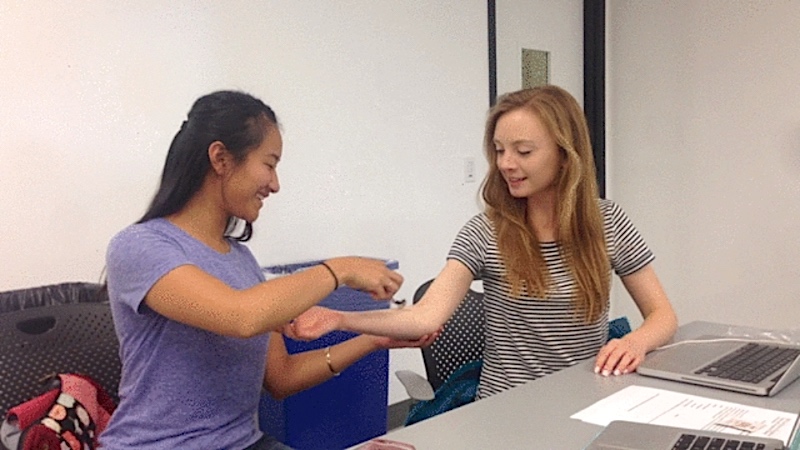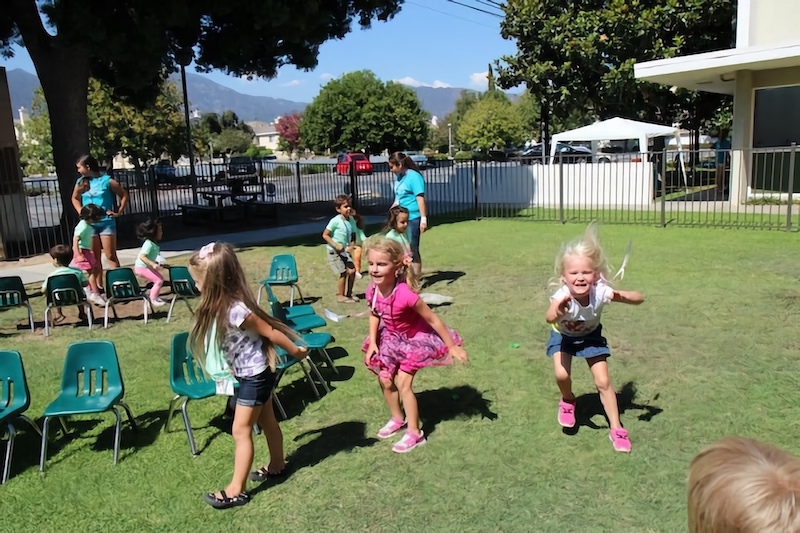Student Blog
Classes

Fieldwork Fun! ⟩
October 20, 2016, by JRoe
Classes Fieldwork
This past week was what we like to call fieldwork week. With each immersion (adult rehabilitation, pediatrics, and mental health), there is an accompanying level I fieldwork in that practice area. Normally we only go one day a week for the full day, but last week we did not have class and only went to fieldwork. Level I fieldwork is a great opportunity to observe and maybe apply skills we learned in class to the OT real world.
I am in adult rehab this semester and my fieldwork placement is in an outpatient hands clinic. I have been learning about different conditions and interventions related to the upper extremities. We have seen many different prefabricated splints and exercises commonly seen in hand therapy. We enjoyed learning about the benefits of different physical agent modality (PAM) techniques, including paraffin wax, which I can now say from personal experience that it feels great.

This week in class, we are learning all about PAMs and hand therapy! In lab, we were able to try all of the different techniques I see in the clinic and read about the different diagnoses I have become familiar with. We even made our own splints! I have a much greater appreciation for the work that hand therapists do.

⋯

Can you feel it? ⟩
September 26, 2016, by JRoe
Classes What are OS/OT?
Hard to believe we are already entering week six and almost at the halfway mark! This semester has gone by so quickly! During this first half of the course, Adult Physical Rehabilitation, we have been learning about different assessments we may administer when we meet our clients. This past week, our focus was on sensation testing on the upper body. Sensation tests look to see if clients can feel things like touch, temperature, or pain on their skin. Without sensation, a person may be at an increased risk for injury, among other thing, and is very important to address. Clients who often have decreased sensation are ones who are recovering from a stroke or a spinal cord injury.
Our professors brought in all sorts of tools that could be used to test our clients’ sensation! One of the coolest tools was called a “pinwheel” and was used to test for pain. This test is commonly administered along the arm.

Another fun assessment to try out was the one used for stereognosis, which is what allows us to find objects with touch alone; the classic example being finding your car keys in your pocket or purse.

We also tested on each other for two-point discrimination, which measures how close two points can be to each other and still recognize them as separate points.

⋯

All fun and games ⟩
September 26, 2016, by Jessica
Classes What are OS/OT?
What I love most about pediatrics is that we often use play, a child’s main occupation, as a means and ends to help a child meet their developmental milestones. And really, who doesn’t love to play?
This past week in pediatrics lab we focus on fine motor coordination assessments and fine motor activities, which included getting to play with a ton of games that can be used to address fine motor coordination skills. Here are some photos of a couple games we played in lab and what they could be used for in practice.

Mr. Mouth game
Mr. Mouth is a game where the goal is to catapult as many flies into the frog’s mouth as possible, while the frog’s mouth is rotating in a circle. There was actually a pretty steep learning curve to this game — it took many missed attempts to figure out that you needed to use less force to get the fly into the frog’s mouth. It can be used to help a child work on isolated finger movement or grading force, which are both important pre-writing skills!

Burger Mania game
Burger Mania is a game where you compete against another person to create a mini burger on the mini conveyor belt before it falls off. You pick a card, and it tells you the type of burger you need to make. The conveyor belt continuously moves, and you have to use these tiny tongs to grab each burger component one at a time to place on the burger in the correct order. This game can be used to work on a child’s ability to use tools, which is also another important pre-writing skill. This game was actually pretty challenging, given the time and speed components. It would be important to keep in mind a child’s frustration tolerance when planning to use this game in therapy.
Overall, pediatrics has definitely helped me with my activity analysis skills. Now whenever I see board games and toys for kids, I can’t help but think about how it can be incorporated into OT practice. Stay tuned for more fine motor goodness in next week’s post!
⋯

Babies! ⟩
September 12, 2016, by Jessica
Classes
Coming into OT school, I was pretty sure I wanted to do pediatrics. I’ve worked with kids in almost all of the jobs I’ve had, in different capacities. So I was super excited for this semester, when it was finally my cohort’s turn to take the pediatric immersion course. Throughout this semester I’ll likely be blogging about all the fun stuff I’m learning in pediatrics — today is focused on positioning babies!
What’s awesome about the labs is that our professors have brought in real children into the lab space in order for us to see how to deliver assessments and how typically developing children interact and play. This past week, our lab focused on assessments for early intervention and how to position infants in order to facilitate proper development for play. Before the real babies came in, we were given doll babies to practice positioning them in different positions (supine, prone, sitting, standing, side-lying, crawling, carrying, etc.). Once the real babies came in, it was game over. All attention went to the adorable little ones, an 8 month old and a 4 month old. We even got a chance to hold and play with them, which was definitely the highlight of my week. Before this class, I didn’t realize how different positions can impact the development of babies’ muscles and bones, and ultimately their ability to meet their developmental milestones. I also didn’t realize how much growth babies go through in their first year, and the nuanced differences between infants just a few months apart. OTs have such a pivotal role in educating caregivers on how to hold and position their babies to facilitate healthy development. Having only experienced working with older children (ages 8+), I’m excited to learn more about opportunities to work in early intervention and how to create collaborative relationships with families.
Since I couldn’t take a picture of the cute real babies, here’s a picture of the slightly creepy doll baby we used to practice.

Doll baby used to practice proper positioning in pediatrics lab
⋯

My Favorite Summer Occupation! ⟩
July 15, 2016, by Megan
Classes Getting Involved What are OS/OT?
One of my all-time favorite occupations is working with kids. This week, I was fortunate enough to help out at a summer day-camp program. I have been involved with this program for 8 years now, and I have got to say it is one of the highlights of my summer. This year has been exciting and different, also, in that I have been able to apply material from the Lifespan Development and Psychology courses I took last semester. Both of these courses (which we take in the Bachelor’s to Master’s program) address fundamental aspects of the development of children, and have been so applicable in daily life this week.

One of my favorite parts about studying to become an OT is how the coursework can be applied to individuals I meet each day, across the lifespan. Even simple activities like working for a summer day-camp are able to reinforce and practically display the material I have learned as an OT major thus far.

I was especially excited this year to be working with a group of crazy, cautious, and adorable TWO-year-olds!! These little ones take a lot of energy and patience, but my heart just melts to see them grinning from ear to ear as we do various crafts, games, lessons and songs.



Not to mention, craft time this week looked a lot like the classrooms here that are currently set up for Creativity, Craft and Activity Analysis — a course the Entry Level Master’s students are currently taking! 😊

Another aspect of OT I have needed to use this week is creativity. Just as an OT takes each patient’s needs into consideration to establish a meaningful treatment plan, I have had to alter my approach when working one-on-one with each child. The toddlers in my group vary in their ability to verbally communicate, follow directions, complete activities . . . or even sit still for over 30 seconds. With this in mind, creativity has improved my ability to communicate with each child and ensured that our group has a productive and fun week!




Nothing I would rather do this week than hang out with these cute kids! Two-year-olds can be tiring, but SO much fun at the same time! If you have some free time and love kids as much as I do, I highly recommend volunteering at a day-camp or summer program!
⋯





